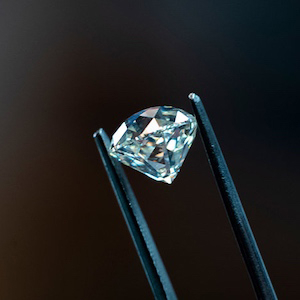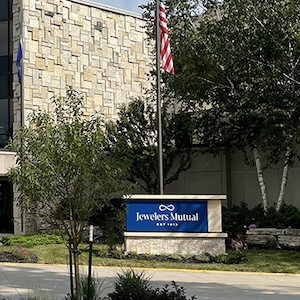
One of the richest men in Israel, Benny Landa (pictured) was named Globes’ “entrepreneur of the decade” in 2016. After making his name in digital printing, he’s gone on to found and fund a number of businesses, including Lusix, which produces lab-grown diamonds.
Here, Landa talks with JCK about why he got into lab-grown diamonds, where he thinks prices and the business are going, and what his company brings to the market that’s different.
Tell me how you got into lab-grown.
First, you should know about the Landa Group. In 1941, my parents escaped Poland to Russia. After the war, I spent the first couple of years of my life in a refugee camp in Germany. My parents had hoped to move to Israel, but at the time, immigration was illegal and so they ended up going to Canada, where I grew up. Then, I moved to Israel because I’m a Zionist, a Jewish patriot.
I started a company in Israel called Indigo, which developed the world’s first digital printing press. And after 25 years, I sold it to Hewlett-Packard. That was 20 years ago. Today, Indigo is not only the largest digital press maker in the world, but it also accounts for one half of 1% of Israel’s GDP, something I’m very pleased with.
I started the Landa Group, and the goal of the Landa Group is to add another 1.5% percent to Israel’s GDP, so that in my lifetime we hit 2% of the country’s GDP. We grow industries in order to affect the economy and to contribute to society. I know it sounds very altruistic, and, of course, it’s business as well, but there’s a higher purpose to this business, it’s not just being successful and making money.
When we started the Landa Group, we started with Landa Labs, which is our research and innovation center. We have 150 researchers in Landa Labs. All they do is R&D. They develop technology, and the business model is very simple: When that technology is proven to be disruptive for a large market, we spin it out as a separate business. We’ve spun out seven businesses so far.
We are a material science company, so all we do is develop material science–based processes. The head of our energy project came to me and said, “I think we have the capability to grow high-quality diamonds.” And he showed me what his thinking was and why he thought we could get there.
And how is Lusix different?
What continues to characterize Lusix is that it’s very science oriented. The entire Landa Group is focused on advanced technologies. Deep technology takes a long time to develop. At Indigo, it took us 16 years before we launched our first product. At Lusix, it has now been 10 years since we started developing the technology.
CVD [chemical vapor deposition] diamond growth itself is not unique. There are many companies that know how to grow diamond. But I dare say, you can count on one hand those that are really advanced. And even amongst those that are really advanced, I think we have some unique capabilities.
What are some of those?
We believe we’re the only diamond company in the industry that knows how to grow rough diamonds to controlled shapes. For example, we grow pyramid-shape diamonds.
That means they’re much closer to the final shape of the polished stone than conventional lab-grown diamonds or than most natural diamonds. And therefore, there’s a higher yield for every carat of rough. Since we control the shape, we can get closer to the end customers’ desired final product.
Another example is that we are able to grow very high-quality color in an “as grown” matter. There is no need to do HPHT [high-pressure, high temperature] treatment afterward. That means that our diamonds don’t have, for example, graininess. Most growers have difficulty growing large stones in a single step. The larger the stone, the more difficult it is to keep the color, the purity, and to have high-quality diamonds. So they grow them in multiple steps, and these multiple steps cause graininess. And most [lab-grown] diamonds have a degree of haze or cloudiness [that] adversely affects their brilliance.
Also we’re able to produce substantial volumes with very consistent properties. When a customer buys a parcel from us, not only are all of the stones within that parcel in a narrow distribution of color and quality, but from parcel to parcel, we have extremely tight control. We produce very consistent product across the line.
We are also very ESG [environmental, social, and corporate governance] focused. We’re [certified sustainability rated] by SCS Global Systems. We’re not the only company certified by SCS, but to also have all these capabilities, that makes us unique.
What quality are you able to grow?
Our main focus is driven by what the customers want. Our primary focus is on F–G color. We can produce D and E colors, but our primary focus is on F and G, in terms of color, and clarity, VS.
How do you see competition from low-cost diamond producers like China and India?
If this was a product that was labor-intensive then we would be worried, because Israel is not an inexpensive country in terms of labor.
If you visit our plant, you will see row upon row of reactors, and you won’t see any people. We believe we have the most advanced CVD diamond–growing plant in existence. We require people to replace the batch and remove the finished diamonds and replace them with new seeds. But apart from that, the plant is completely automated and runs 24/7 [without people].
It’s that technological foundation that we believe will keep us competitive, even with the lowest-cost producers from China or India. I don’t dismiss them; we have a high degree of respect for these producers, but we do not think that they will be able to undermine our position in the market.
We are not focusing on the low-end small stones or lower-quality or commodity markets. We’re focusing on the premium markets, where quality and consistency are paramount and where ESG concerns are paramount.
How many carats do you produce?
That, we don’t disclose.
But you don’t consider yourself among the biggest producers.
No. We are producing from our first factory and our first plant. We are in the process of commissioning our second plant, which will be operational in the second half of this year, and it will increase our output by about a factor of four.
Do you expect to be among the leading gem producers in the future?
Yes.
Some lab-grown producers have begun brands. Do you plan that?
We want to start by becoming a known name in the industry across the entire pipeline. But you have to walk before you can run. First, we want to establish our name as the premium producer of rough, especially for the premium brands.
How do you see lab-grown prices?
We have seen prices decline. We think it’s plateauing, if not even recovering somewhat. We don’t see that as a problem for Lusix, because we think that we will be able to produce our goods at costs which will enable us to be competitive. With automation and high science, we think we can produce quite economically and competitively.
A lot of lab-grown diamond companies are pivoting to tech applications. Do you see yourself doing that?
Currently, we’re focused completely on gem-quality stones. But the ability to develop technology based on theoretical models, the ability to have extremely consistent production, and the ability to produce very pure diamond are fundamental prerequisites to go into some of the more advanced technological applications, such as semiconductors. Gem-quality diamonds are orders of magnitude less pure than what is required to turn diamond into reliable semiconductors.
We are developing a platform on which we will then be able to base our more sophisticated applications other than gems. Everything that we are developing, we have the technological capabilities in the back of our minds.
So you’re strictly in gems for now?
[We’re] a gem play for now, in no small measure because of the enormous amount of research required to be able to produce diamond-based semiconductors or quantum computing or any these other fabulous wonderful future applications. We will have a real huge opportunity there, but I strongly believe in focus. We have to focus on our main objective, and our main objective is to ramp up production to meet the huge demand that we’re facing and cement our reputation in the market.
Any other thoughts?
Everyone talks about the competition between lab-grown diamonds and mined diamonds. I don’t see it that way. If what’s really important for consumers is that the stone on their finger was created millions of years ago below the earth, we will never be able to compete with that emotional aspect.
But for some, that’s not a big factor. What is a bigger factor is the quality, the value. For the same money, you can get a [bigger] diamond. There’s been huge demand for this better-value proposition.
Mined diamonds and lab-grown, like most other industries, will continue to coexist, like electric cars and internal combustion engines, and mechanical printing and digital printing. We’re leading a revolution in digital printing, but mechanical printing will continue for many years. Every technology has its sweet spot.
I’m not enamored with this competition [between natural and lab-grown]. The real competition is for the customers’ wallet.
(Photo courtesy of Lusix)
Follow JCK on Instagram: @jckmagazineFollow JCK on Twitter: @jckmagazine
Follow JCK on Facebook: @jckmagazine





